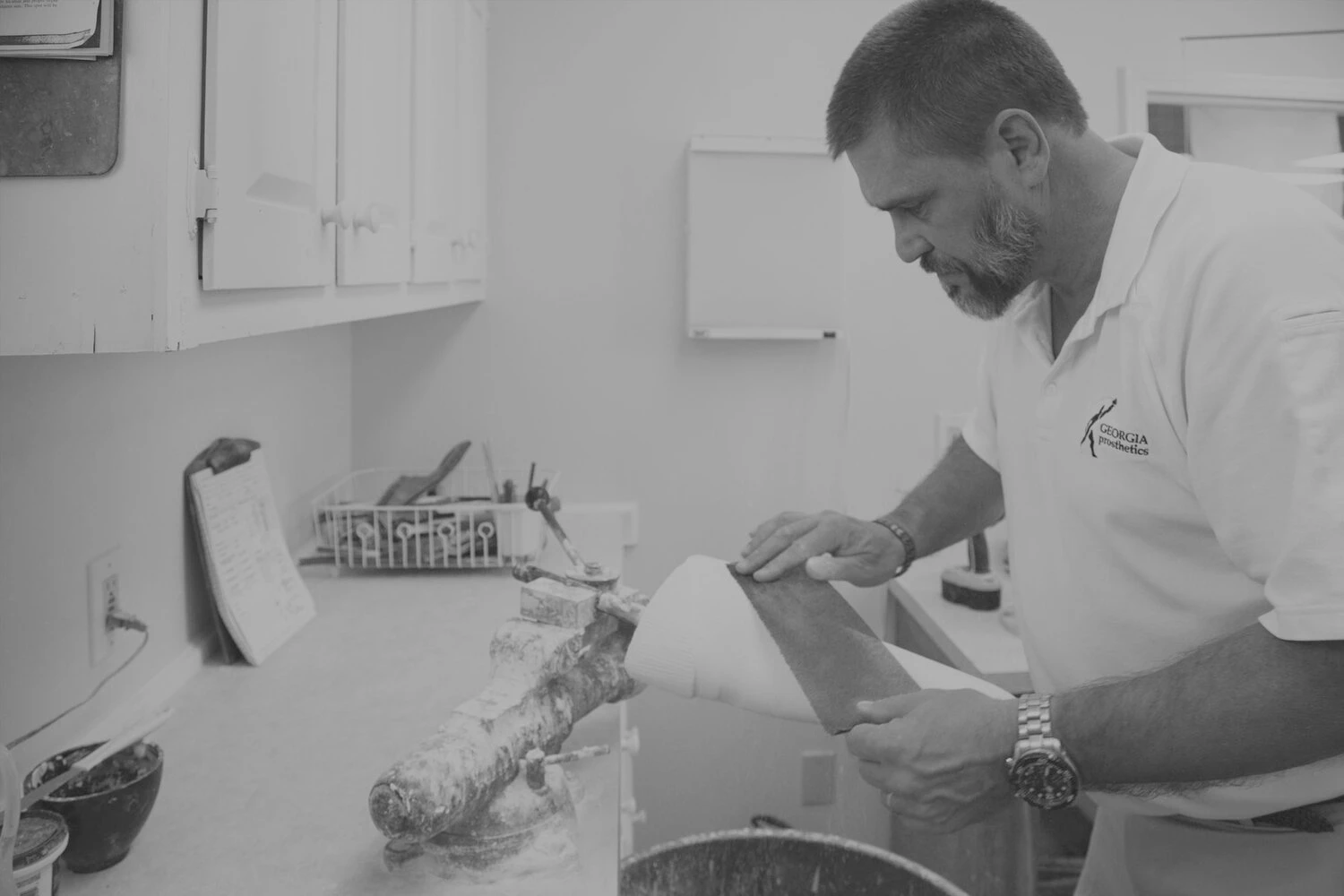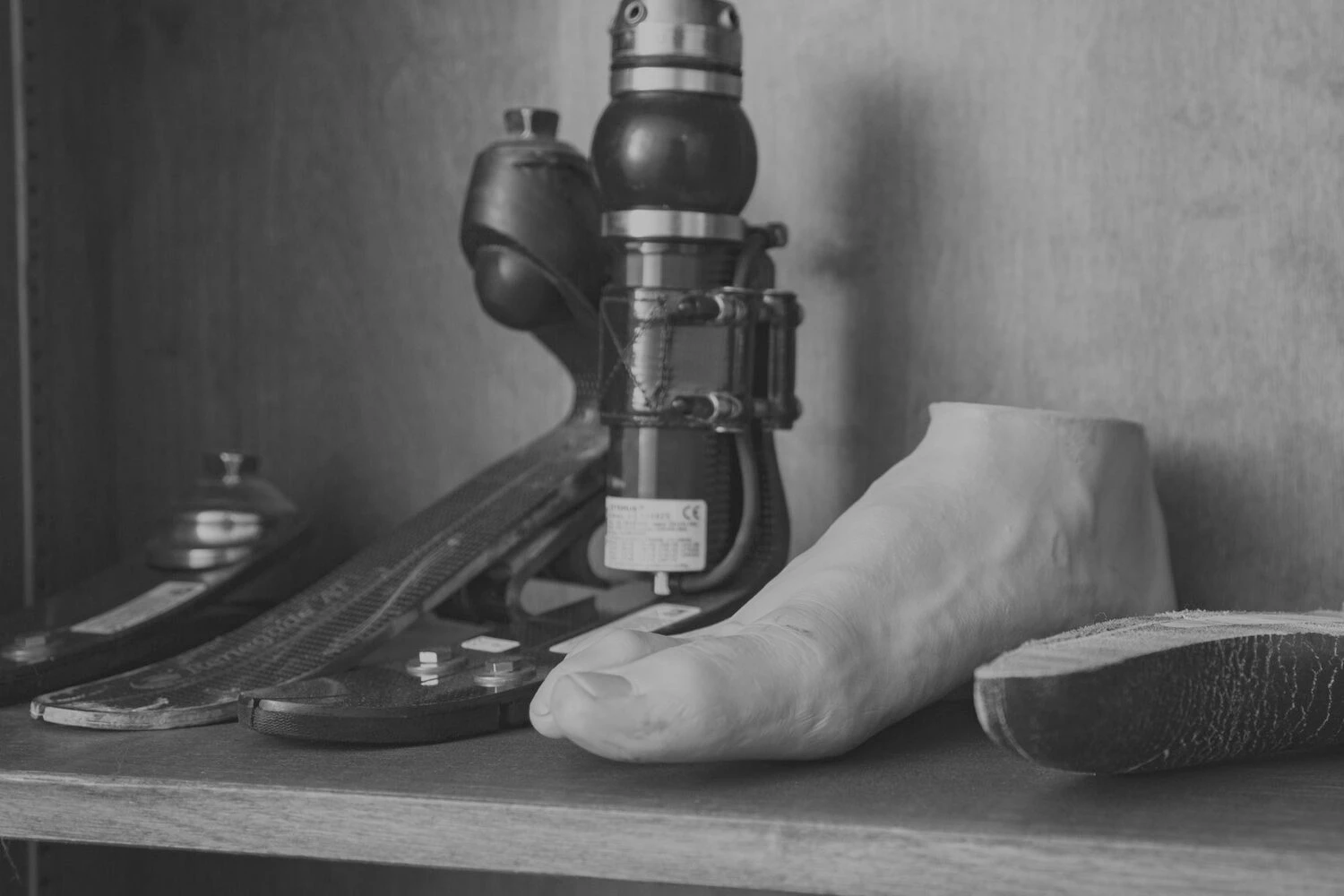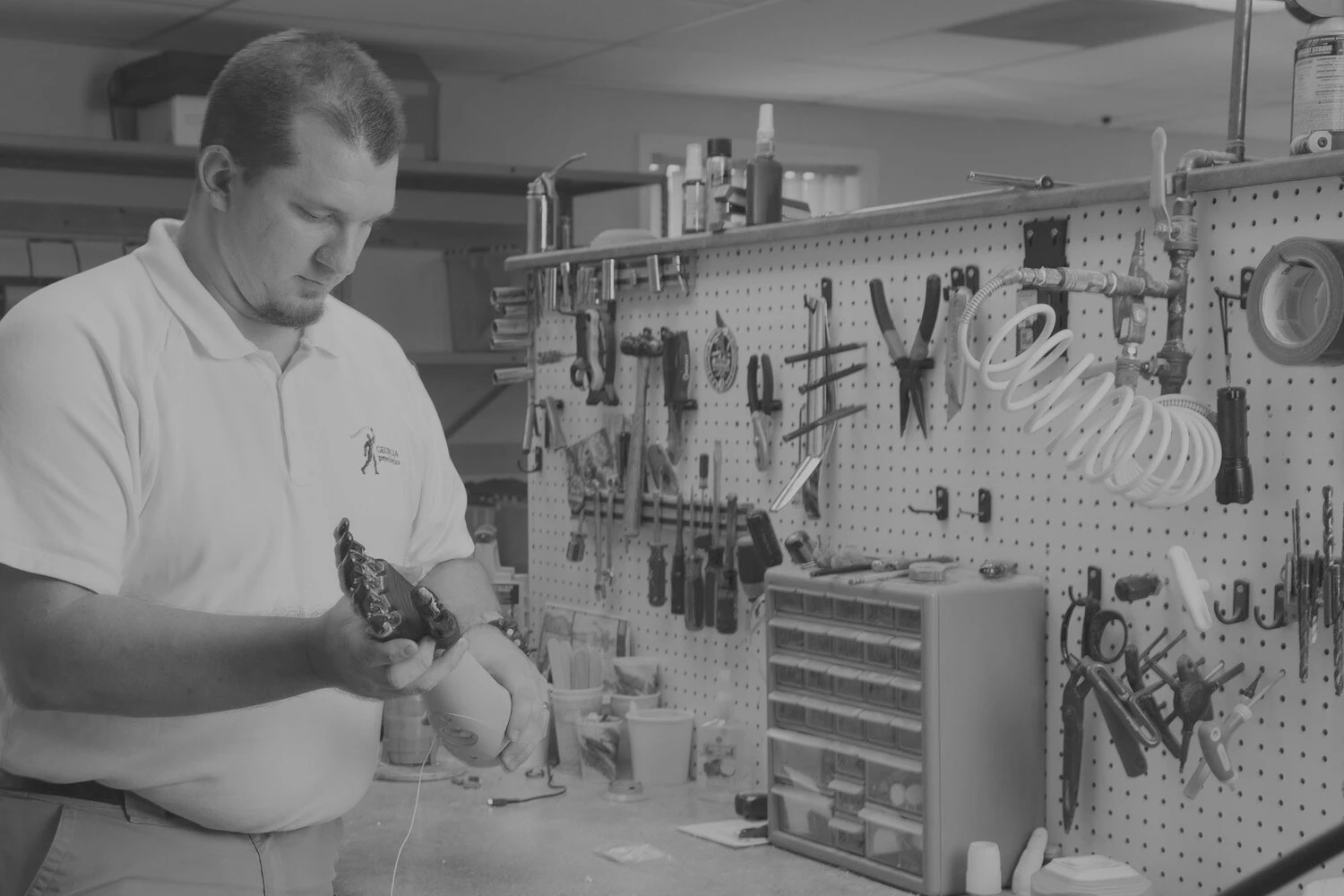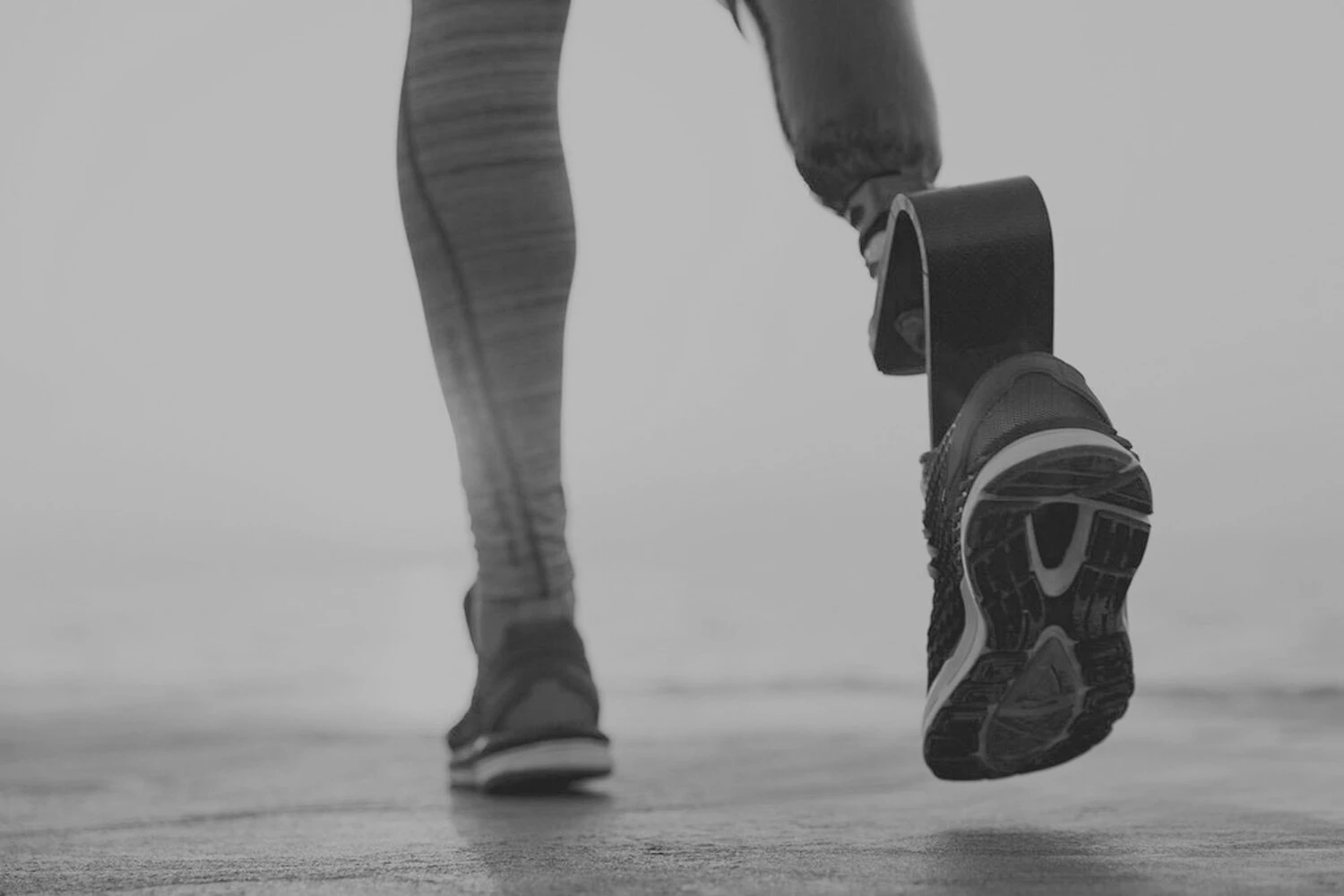
We Are Artisans
At Georgia Prosthetics, we believe that by creating custom prosthetics and products that utilize the latest technology and the highest quality materials, we are able to provide patients with pain-free prosthetic solutions.
The prosthetics field is constantly evolving, with newer, more advanced technology constantly being developed. These advancements can make a tremendous difference in the life of an amputee. We place great importance on making sure the prosthesis is not only highly functional, but also comfortable to use.
Made by hand, heart, and soul in the USA, our technicians build each prosthetic by paying special attention to detail that results in a comfortable, long-lasting fit that fit his/her lifestyle.
Located in Atlanta, Georgia, we have been proudly serving amputees in the southeast since our founding in 1964. We are certified and accredited by the American Board for Certification in Orthotics, Prosthetics & Pedorthics.
Georgia Prosthetics Provided Prosthesis for:



 Here you’ll be treated like family.
Here you’ll be treated like family.
At Georgia Prosthetics, there is a caring and passionate person behind each prosthetic made. Our team of experienced, caring professionals are committed to helping patients achieve the highest levels of function and comfort possible. In addition to superior craftsmanship, patients can expect personalized service and excellent care. We are passionate about what we do and we are committed to seeing each patient achieve success with his or her custom prosthetics, pain-free device.
Meet Your New Family 🙂

Custom Prosthetics Without Pain
Solutions to Meet Your Lifestyle
Georgia Prosthetics offers a wide range of services to meet the needs of each and every patient – including upper extremity prosthetics, knees, feet, and high-performing sockets. We expertly and carefully match top-of-the-line custom prosthetics products to meet the needs of our patients. We help our clients with all types of lifestyles who need a device to perform simple, daily tasks or those who participate in high-intensity athletics.

Featured Stories
Featured Videos

Testimonials
⭐⭐⭐⭐⭐
No B.S. if you want to speak to me personally or see photos or even meet me to see what this trifecta has done for me, call them and I’ll give you my personal contact info to show you The Real Deal. Stop suffering and make the most important decision of your life.
– John Wesley Newton
⭐⭐⭐⭐⭐
“They’re simply a nice group of people whose top priority is providing the patient with the best fitting prosthesis possible and not giving up until that goal is accomplished. But for the efforts of Georgia Prosthetics, my quality of life would not be what it is today.”
– Gary P.
⭐⭐⭐⭐⭐
“I would highly recommend Dan to anyone who had to go through the same things I’ve been through. My experience with Dan and his staff has drastically improved my life.”
-Michael M.
⭐⭐⭐⭐⭐
“Thank you! Dan, Ryan and Cindy, you were spectacular!”
-Jeff Smith
⭐⭐⭐⭐⭐
“Georgia Prosthetics is a super clean, well tooled facility with knowledgable, expert craftsmen. Cindy went out of her way to make sure my stay was comfortable.”
-Dave Jones
⭐⭐⭐⭐⭐
“From the first exploratory phone call, Cindy, Ryan and Dan have been amazingly helpful and have given me back my life.”
-Tim Banks
⭐⭐⭐⭐⭐
“I love my new prosthesis. The fit is perfect and there was no break in period needed.”
– C.C.
⭐⭐⭐⭐⭐
“I highly recommend Georgia Prosthetics for its professionalism, technical expertise, and personalized care.”
– Susan

An Investment You Can Trust
High Quality Prosthesis Created for You!
We understand that a prosthetic device is a significant investment. We make it as easy as possible to obtain a high-quality prosthesis. We accept Medicare, Medicaid, and most private insurance.
We charge no consultation fees, provide expedited fabrication for patients in the Southeast, and we accept emergency cases without appointments. In addition, we file all necessary forms for you and offer payment plans to best suit your needs.
We believe that, with the right prosthesis, any amputee can live an active, independent lifestyle. Our mission is to make that happen. If you or a loved one is in need of a high quality, pain-free prosthetic device, we want to work with you.
Contact our office today to schedule a free consultation and to speak with one of our experienced clinicians!

Frequently Asked Questions
No, it should not hurt when you walk with your prosthesis. While some discomfort might be expected initially as your body adapts to the prosthesis (and there’s a break-in period of a couple weeks), persistent pain or significant discomfort is not normal. Here are some key points to consider:
- Fit of the Prosthesis
-
- Ill-Fitting Socket: Pain can occur if the prosthetic socket (the part that interfaces with your residual limb) does not fit properly.
- Pressure Points: Uneven weight distribution or poorly adjusted components can lead to pressure sores or pinching.
- Volume Changes: Residual limb size can fluctuate due to swelling or weight changes, affecting fit.
- Alignment and Adjustments
-
- A misaligned prosthesis can cause pain in the residual limb, hips, knees, or back. Regular checkups with a prosthetist are crucial for proper alignment and adjustments.
- Soft Tissue and Skin Issues
-
- Irritation: Friction between the limb and socket can cause skin irritation or blistering.
- Infection: Pain could indicate an underlying skin infection, especially if accompanied by redness, swelling, or warmth.
- Gait and Usage
-
- Incorrect walking patterns or overuse can strain muscles and joints, leading to pain.
- Working with a physical therapist can improve gait and ensure optimal use of the prosthesis.
- Residual Limb Health
-
- Bone Spurs: Growth of bone spurs can cause pain when pressure is applied.
- Neuroma: Nerve endings in the residual limb may form a painful neuroma, requiring medical attention.
What You Should Do:
- Contact Your Prosthetist: If pain persists, schedule an appointment with your prosthetist for an evaluation and possible adjustments.
- See Your Doctor: If there are signs of infection, nerve pain, or other medical issues, consult your healthcare provider.
- Physical Therapy: A therapist can help ensure your prosthesis fits well with your movement and activity levels.
Pain is a signal that something is not right. Addressing it promptly can prevent complications and improve your comfort and mobility.
Prostheses are expensive due to the complexity of their design, materials, and manufacturing process, as well as the specialized expertise required to create and fit them. Below are the key reasons contributing to their high cost:
- Advanced Technology
Modern prostheses often incorporate cutting-edge technologies, such as:
-
- Microprocessors: Found in bionic limbs, these provide real-time adjustments to improve functionality and ease of use.
- Sensors and Motors: Enhance movement precision and responsiveness.
- Custom Software: Used to program and fine-tune the prosthetic to meet the user’s needs.
These technologies require significant research and development (R&D), which increases costs.
- High-Quality Materials
Prostheses are made from durable, lightweight, and specialized materials:
-
- Carbon Fiber: Provides strength and flexibility while being lightweight.
- Titanium: Offers durability and resistance to corrosion.
- Medical-Grade Plastics and Silicones: Provide comfort and reduce skin irritation.
These materials are costly to produce and process.
- Customization
Each prosthesis is tailored to the individual:
-
- Unique Fit: The prosthetic socket is custom-molded to the user’s residual limb.
- Functional Needs: Adaptations are made based on the user’s lifestyle, activity level, and goals.
- Time-Intensive Process: Crafting and fitting a prosthesis often involve multiple fittings, adjustments, and testing.
- Specialized Expertise
Creating and fitting a prosthesis requires skilled professionals:
-
- Prosthetists: Experts who assess the user’s needs, design, and fit the device.
- Physical Therapists: Help users adapt and maximize functionality.
- Engineers and Designers: Innovate and refine prosthetic technologies.
The training and experience required for these roles contribute to overall costs.
- Manufacturing and R&D
-
- Small Market Scale: Unlike mass-produced consumer products, prostheses are produced in smaller quantities, which increases per-unit costs.
- Regulatory Compliance: Prostheses must meet strict medical device standards, involving rigorous testing and certification processes.
- Long-Term Support
The cost often includes:
-
- Regular maintenance and repairs.
- Replacement parts or liners.
- Adjustments as the user’s needs change.
- Insurance and Healthcare Systems
-
- Limited Coverage: Insurance may not fully cover the cost of advanced prostheses, leaving users to pay significant out-of-pocket expenses.
- Administrative Costs: Navigating insurance claims and compliance adds to overall costs.
Conclusion
The high cost of prostheses reflects the combination of sophisticated technology, customization, and the expertise required to meet individual needs. Despite these costs, ongoing innovations aim to make prosthetics more affordable and accessible over time.
The length of time you can comfortably and safely wear your prosthesis depends on factors such as the stage of adjustment, the condition of your residual limb, and the type of prosthesis. Here’s a breakdown:
- During the Initial Adjustment Period
-
- Short Periods (1-3 Hours): For new prosthesis users, it’s important to gradually build up wear time. Start with a few hours per day to allow your residual limb to adapt and prevent irritation.
- Frequent Breaks: Remove the prosthesis regularly to check your skin for redness, irritation, or sores.
- After Adjusting to the Prosthesis
-
- 8-12 Hours a Day: Most experienced users can wear their prosthesis for the majority of their waking hours. However, this depends on individual comfort, activity levels, and the condition of the residual limb.
- Breaks as Needed: Take breaks during the day if you feel discomfort, notice swelling, or experience skin irritation.
- Special Considerations
-
- Skin Health: If your skin becomes irritated or shows signs of pressure sores, limit wear time and consult your prosthetist for adjustments.
- Residual Limb Volume: Swelling or changes in limb size might require shorter wear times or adjustments to the prosthesis.
- Activity Levels: High-impact activities or prolonged use might require additional breaks to prevent strain on your residual limb or the rest of your body.
- Overnight Use
-
- Remove for Sleeping: Prostheses are generally not designed to be worn while sleeping. Removing it allows your residual limb to rest and your skin to recover.
Signs You Should Reduce Wear Time
- Persistent discomfort or pain.
- Redness or pressure marks lasting longer than 20-30 minutes after removing the prosthesis.
- Skin irritation, blisters, or sores.
- Swelling or numbness in your residual limb.
Consult Your Prosthetist
- If you experience discomfort or have concerns about wear time, a prosthetist can help optimize the fit or recommend solutions to increase comfort and usability.
The goal is to achieve a balance that maximizes comfort, functionality, and skin health. As you gain experience and your limb adapts, you’ll likely find the wear schedule that works best for you.
Prostheses require regular maintenance and occasional repairs to ensure optimal functionality, safety, and comfort. Maintenance needs vary based on whether you have an upper or lower extremity prosthesis, but many aspects are similar. Here’s what you can expect:
General Maintenance and Repairs
- Daily Cleaning
- Socket: Clean the inside of the socket with mild soap and water or a prosthetist-recommended cleaner to prevent skin irritation and odor.
- Liners: Wash liners daily to remove sweat and bacteria, ensuring they remain comfortable and hygienic. Liners should be replaced annually.
- Joints and Components: Check for dirt, debris, or moisture that could interfere with moving parts.
- Regular Inspection
- Look for cracks, wear, or loose components in the prosthesis.
- Check straps, belts, and suspension systems for signs of wear or stretching.
- Monitor fasteners and screws to ensure they remain tight and secure.
- Lubrication
- Some prosthetic components, such as joints or moving parts, may require occasional lubrication. Use only prosthetist-approved lubricants to avoid damage.
- Repairs and Replacement
- Mechanical Issues: Replace worn-out parts, such as hinges, joints, or cables.
- Cosmetic Covers: Replace torn or damaged covers to maintain the prosthesis’s appearance and protect internal components.
- Electronics: For advanced prostheses with microprocessors or sensors, ensure repairs are handled by certified technicians.
Specific to Lower Extremity Prostheses
- Feet and Ankles
- Inspect for wear on foot shells or soles. Replace them when they lose tread or show significant wear. It’s typical to replace every 1-2 years.
- Advanced foot/ankle systems with microprocessors may require software updates or recalibration.
- Knees
- Hydraulic or pneumatic knees may need fluid checks and occasional refills.
- Ensure proper alignment and smooth movement.
- Suspension Systems
- Check for wear or damage in suction valves, pins, or other suspension mechanisms.
- Alignment
- Regularly assess alignment to prevent discomfort, gait issues, or uneven wear on components.
Specific to Upper Extremity Prostheses
- Terminal Devices
- Hands or Hooks: Ensure proper tension, smooth operation, and alignment of moving parts.
- Bionic Hands: Replace batteries, recalibrate sensors, or update software as needed.
- Cables and Harnesses
- Inspect for fraying or weakening of cables in body-powered prostheses.
- Adjust or replace harnesses to maintain a comfortable and functional fit. Cables and harnessing should be replaced annually.
- Wrist Units
- Ensure wrist rotation or locking mechanisms operate smoothly and securely.
Routine Professional Checkups
- Schedule regular appointments with your prosthetist (every 6-12 months or as recommended) to:
- Check the fit and alignment of the prosthesis.
- Address any discomfort or issues with functionality.
- Perform preventive maintenance or repairs to avoid larger issues.
Signs You Need Immediate Repairs
- Unusual noises (e.g., clicking or grinding).
- Difficulty in moving joints or parts.
- Pain, discomfort, or skin irritation.
- Looseness or instability when using the prosthesis.
- Reduced battery life or malfunctions in electronic components.
Proactive Care Saves Time and Money
Staying on top of maintenance and addressing small issues early can extend the life of your prosthesis, improve comfort, and prevent expensive repairs or replacements in the future. Always follow the manufacturer’s and prosthetist’s specific maintenance recommendations.
Patients should plan to see their prosthetist 1-2x per year.
The lifespan of a prosthesis depends on factors such as the type of prosthesis, its materials, how often it’s used, and how well it’s maintained. On average:
General Lifespan
- Prosthetic Components:
- 3 to 5 Years: Most prosthetic components, such as the socket, joints, and feet, typically last 3 to 5 years under normal use. However, high-impact activities may shorten this lifespan.
- Microprocessor or Bionic Parts: Advanced prostheses with electronics may last longer but might require repairs, software updates, or component replacements during their lifespan.
- Socket:
- 1 to 3 Years: The socket (the part that interfaces with your residual limb) often needs replacement more frequently than other components. Changes in residual limb size, shape, or volume can affect fit and comfort.
Factors Affecting Lifespan
- Usage:
- Heavy or high-impact use, such as running, sports, or physically demanding jobs, can wear out components faster.
- Daily wear and tear from regular activities can also gradually degrade parts.
- Residual Limb Changes:
- Fluctuations in weight, muscle tone, or residual limb volume can require adjustments or replacement of the socket or suspension system.
- Materials:
- Durable Materials: Prostheses made with carbon fiber, titanium, or high-strength plastics often last longer.
- Less Durable Components: Cosmetic covers, liners, and soft materials may wear out more quickly.
- Maintenance:
- Regular cleaning, inspections, and professional adjustments can extend the prosthesis’s life.
- Neglecting maintenance can lead to premature wear or malfunction.
Lifespan of Upper vs. Lower Extremity Prostheses
- Upper Extremity Prostheses:
- Tend to last longer because they experience less weight-bearing stress.
- Frequent replacement of cables or terminal devices (like hooks or hands) may be needed in body-powered systems.
- Lower Extremity Prostheses:
- Components like feet, knees, and sockets endure significant stress and wear.
- Replacement may be needed more often, especially for active individuals.
When to Replace a Prosthesis
- Signs of Wear: Cracks, loose parts, or reduced functionality.
- Poor Fit: Discomfort or pain due to changes in your residual limb.
- Technological Advancements: Upgrading to newer, more advanced models may improve your quality of life.
Consult Your Prosthetist
Your prosthetist will monitor the condition of your prosthesis and recommend repairs or replacements as needed. Regular checkups (every 6-12 months) are essential to ensure your prosthesis remains functional and comfortable.
By maintaining your prosthesis and addressing small issues early, you can maximize its lifespan while ensuring it continues to meet your needs.
Whether or not you will have a limp when walking with a prosthesis depends on several factors, including your level of amputation, the type of prosthesis, your physical condition, and the effort put into rehabilitation and gait training. Here’s an overview:
Factors Influencing Limping
- Level of Amputation
- Below-Knee (Transtibial) Amputation: People with transtibial prostheses are less likely to have a noticeable limp, as the knee joint is preserved, allowing for more natural movement.
- Above-Knee (Transfemoral) Amputation: Walking with an above-knee prosthesis can be more challenging because the prosthetic knee must replicate natural joint movement.
- Prosthesis Fit
- A well-fitted prosthesis reduces discomfort and improves balance and stability, making it easier to walk without a limp.
- An ill-fitting prosthesis may cause pain or instability, leading to compensatory movements that result in a limp.
- Type of Prosthesis
- Basic Prostheses: May lack advanced features like microprocessors or energy-return feet, which can affect gait smoothness.
- Advanced Prostheses: Devices with microprocessors, hydraulics, or energy-return technology can significantly improve walking dynamics and reduce limping.
- Strength and Mobility
- Strong residual limb muscles, core strength, and overall fitness contribute to better gait and balance, reducing the likelihood of a limp.
- Weakness or imbalance may make it harder to walk smoothly.
- Rehabilitation and Gait Training
- Physical therapy and gait training are critical for learning to walk effectively with a prosthesis.
- Improper gait patterns can cause limping and may lead to secondary issues like joint pain or back problems.
What You Can Do to Minimize Limping
- Work with a Prosthetist
- Ensure your prosthesis is properly fitted and aligned.
- Address any discomfort, instability, or uneven pressure.
- Engage in Physical Therapy
- A physical therapist can help strengthen your muscles and improve your balance, posture, and walking mechanics.
- Gait training focuses on reducing compensatory movements that cause limping.
- Practice and Patience
- Learning to walk smoothly with a prosthesis takes time and practice.
- Be consistent with exercises and follow your rehabilitation plan.
- Use Assistive Devices Temporarily
- Initially, you may use crutches, a cane, or a walker to build strength and confidence while minimizing limping.
- Over time, as you improve, you may no longer need these aids.
- Address Psychological Factors
- Confidence plays a significant role in walking naturally. Support groups or counseling can help you build self-assurance.
Possible Challenges
Even with the best prosthesis and training, some individuals may have a slight limp due to factors like:
- Short residual limbs, which can affect balance and weight distribution.
- Joint stiffness, pain, or other physical limitations.
Outlook
With a well-fitted prosthesis, proper rehabilitation, and consistent effort, many people can achieve a smooth and natural gait. While some may experience a slight limp, ongoing adjustments and training can help improve walking mechanics over time.
A prosthesis stays on through a combination of secure attachment systems, custom design, and the use of materials that create a snug and comfortable fit. The exact method depends on the type of prosthesis, the level of amputation, and the individual’s needs. Here are the most common methods used:
- Socket Design
The prosthetic socket is the part that interfaces with the residual limb. It is custom-molded to the shape of the limb to ensure a secure fit and distribute weight evenly.
- Total Surface Bearing (TSB) Sockets: Provide even pressure distribution across the entire residual limb.
- Specific Weight-Bearing Sockets: Apply pressure to certain areas while relieving sensitive spots.
- Suspension Systems
A suspension system holds the prosthesis securely in place, preventing it from slipping or shifting during use. Common types include:
- Suction Suspension
- How It Works: Creates a vacuum seal between the prosthetic socket and the residual limb.
- Components: May use a one-way valve or a sealing sleeve to maintain the suction.
- Benefits: Provides a secure fit and minimizes movement of the prosthesis.
- Pin Lock System
- How It Works: Involves a locking pin attached to the liner that clicks into a mechanism at the bottom of the socket.
- Components: A gel or silicone liner with an embedded pin.
- Benefits: Easy to use and provides a reliable hold.
- Sleeve Suspension
- How It Works: Uses a flexible, neoprene or silicone sleeve that fits over the prosthetic socket and extends onto the residual limb.
- Benefits: Provides additional security and is often used in combination with other suspension methods.
- Vacuum-Assisted Suspension (VAS)
- How It Works: Uses a pump to create a vacuum between the socket and the liner.
- Benefits: Reduces pressure points and improves prosthesis stability, particularly during high activity.
- Harness Systems
- How It Works: Commonly used for upper extremity prostheses, a harness straps around the shoulder or torso to keep the prosthesis in place.
- Benefits: Simple and effective, especially for body-powered prostheses.
- Liners
Soft liners made of silicone, gel, or foam cushion the residual limb and improve comfort while enhancing the fit between the socket and limb. Liners often play a role in suspension systems as well.
- Prosthetic Socks
Prosthetic socks are used to adjust the fit of the prosthesis. Adding or removing layers helps compensate for daily fluctuations in the size of the residual limb due to swelling or shrinkage.
- Specialized Attachments
- Belts or Straps: Provide additional security and are often used with older or less advanced prostheses.
- Osseointegration: A surgical method where a metal implant is placed directly into the bone, and the prosthesis attaches to the implant. This eliminates the need for a socket and provides a highly secure connection.
Key Factors for Success
- Proper Fit: A custom-molded socket ensures a secure attachment without causing pain or discomfort.
- Regular Adjustments: Residual limb changes over time may require modifications to maintain a secure fit.
- Daily Care: Cleaning the socket, liner, and suspension system prevents slipping due to sweat or debris.
By combining these methods, prostheses can remain securely attached during everyday activities and even high-impact movements, providing stability and confidence to the wearer.
Back pain after walking with a prosthesis is a common issue and can be caused by several factors related to posture, alignment, and muscle strain. Understanding the root cause is essential to addressing the problem. Here are the main reasons for back pain and ways to alleviate it:
- Improper Prosthetic Alignment
-
- Cause: If your prosthesis is not properly aligned, it can cause uneven weight distribution or abnormal gait patterns, leading to strain on your back.
- Solution: Consult your prosthetist to adjust the alignment. Regular checkups ensure the prosthesis functions optimally.
- Poor Fit of the Prosthesis
-
- Cause: An ill-fitting prosthetic socket can cause compensatory movements, like limping or twisting your torso, which can strain your back muscles.
- Solution: Ensure the socket fits snugly and comfortably. Changes in your residual limb may require adjustments or a new socket.
- Uneven Leg Length
-
- Cause: If the prosthetic leg is slightly too long or too short compared to the other leg, it can cause an imbalance, leading to back pain over time.
- Solution: Have your prosthetist measure and adjust the leg length for symmetry.
- Muscle Imbalances or Weakness
-
- Cause: Walking with a prosthesis requires different muscle groups to compensate, potentially leading to imbalances or overuse of certain muscles in the back and core.
- Solution: Work with a physical therapist to strengthen your core, back, and residual limb muscles. This helps improve posture and gait stability.
- Gait Abnormalities
-
- Cause: If your walking pattern is uneven or inefficient, it can lead to excess stress on your lower back.
- Solution: Gait training with a physical therapist can help you develop a smoother, more natural walking motion.
- Overuse or Fatigue
-
- Cause: Prolonged walking, especially for new prosthetic users, can lead to muscle fatigue and strain, causing back pain.
- Solution: Gradually increase walking duration and intensity. Take regular breaks to rest and avoid overexertion.
- Poor Posture
-
- Cause: Adapting to a prosthesis can lead to compensatory postures, like leaning forward or to one side, which can strain the spine.
- Solution: Focus on maintaining an upright posture while walking. A physical therapist can help identify and correct posture issues.
- Residual Limb Issues
-
- Cause: Pain or discomfort in the residual limb can lead to altered walking mechanics, which can transfer strain to the back.
- Solution: Address any residual limb pain with your prosthetist, such as by adjusting the socket or suspension system.
- Weight of the Prosthesis
-
- Cause: A heavier prosthesis may cause asymmetrical loading, putting extra strain on your back.
- Solution: Discuss with your prosthetist whether a lighter prosthetic option is feasible for your needs.
When to Seek Help
-
- Persistent Pain: If back pain continues despite adjustments and therapy, consult a healthcare provider.
- Signs of Injury: Sharp or worsening pain, numbness, or tingling could indicate a more serious issue, such as a spinal or nerve problem.
Proactive Steps to Prevent Back Pain
- Regular Prosthetic Maintenance: Ensure your prosthesis is in good condition and fits well.
- Physical Therapy: Strengthen muscles and improve gait.
- Stretching: Incorporate stretching exercises to keep your back and leg muscles flexible.
- Proper Footwear: Wear supportive shoes to enhance balance and reduce strain.
Back pain after walking with a prosthesis is manageable with the right adjustments and care. Working closely with your prosthetist and physical therapist can help identify and address the underlying causes, leading to improved comfort and mobility.
Taking proper care of your prosthesis is essential for maintaining its functionality, comfort, and longevity. Here’s a comprehensive guide on how to take care of your prosthesis:
- Daily Cleaning
Keeping your prosthesis clean prevents skin irritation, bacterial buildup, and odors.
-
- Socket:
- Wipe the inside of the socket daily with a damp cloth and mild soap.
- Dry thoroughly to avoid moisture accumulation.
- Liner:
- Wash liners with warm water and a gentle, prosthetist-recommended cleaner.
- Air dry completely before use.
- Foot Shells or Covers:
- Clean cosmetic covers with a damp cloth. For more stubborn dirt, use a mild soap solution.
- Socket:
- Regular Inspection
-
- Daily Checks:
- Inspect for cracks, loose components, or unusual wear on the socket, joints, and other parts.
- Check straps, belts, and fasteners for signs of wear or damage.
- Weekly Checks:
- Examine the foot shell or sole for wear, especially if your prosthesis is weight-bearing.
- Look for debris or dirt in moving parts, like joints or locks.
- Daily Checks:
- Protect Against Moisture
-
- Avoid getting your prosthesis excessively wet unless it’s specifically designed for water use.
- If exposed to water, dry it thoroughly to prevent rust or damage to components.
- Prevent Wear and Tear
-
- Avoid unnecessary impact or rough usage that could damage delicate components.
- Use your prosthesis only for activities it’s designed for. For high-impact sports or water activities, consult your prosthetist for specialized options.
- Maintain Proper Fit
-
- Over time, your residual limb may change in size or shape due to weight changes, swelling, or atrophy.
- Address any discomfort, looseness, or pressure points with your prosthetist as soon as possible to adjust the fit or alignment.
- Lubricate and Adjust Moving Parts
-
- If your prosthesis has moving parts (e.g., joints in a lower extremity prosthesis), check for smooth operation.
- Use only prosthetist-recommended lubricants. Avoid using household oils or grease.
- Replace Consumable Parts
-
- Liners and Socks: Replace liners and prosthetic socks regularly to ensure proper hygiene and comfort.
- Foot Shells: Replace foot shells when they become worn or lose their tread.
- Suspension Systems: Check for wear and replace straps, sleeves, or pins as needed.
- Professional Maintenance
-
- Schedule regular appointments with your prosthetist, typically every 6-12 months, to:
- Inspect and fine-tune your prosthesis.
- Replace worn-out components.
- Ensure proper alignment.
- Schedule regular appointments with your prosthetist, typically every 6-12 months, to:
- Handle Electronics Carefully (If Applicable)
If your prosthesis includes microprocessors, sensors, or motors:
-
- Keep it away from extreme heat, cold, or moisture unless it’s specifically built for such conditions.
- Charge the device according to the manufacturer’s guidelines.
- Notify your prosthetist immediately if you notice unusual noises, reduced performance, or battery issues.
- Storage and Transport
-
- Store your prosthesis in a clean, dry area when not in use.
- When traveling, use a protective case to prevent damage.
- Protect Your Skin
-
- Clean your residual limb daily and monitor for signs of irritation, redness, or sores.
- Use moisturizers or barrier creams as recommended by your prosthetist to prevent dryness or chafing.
When to Contact Your Prosthetist
- Persistent discomfort or pain.
- Unusual noises, looseness, or movement in the prosthesis.
- Visible damage to the socket, joints, or suspension system.
- Malfunctioning electronics or sensors.
Proper prosthetic care ensures that it stays functional, comfortable, and safe to use, while also reducing the need for frequent repairs or replacements. Consistency in maintenance will help you get the most out of your prosthesis.
Bottom Line:
- Plan to visit your prosthetist 1-2x/year.
- Baby Shampoo is preferred over other cleaning products.
- Liners should be washed after every use.
Wear your liners on alternate days.
When selecting shoes to wear with your prosthesis, the primary goals are comfort, stability, and proper alignment. Different types of shoes can work, but some options are better suited for use with prostheses. Here’s a detailed guide:
Best Types of Shoes
- Athletic or Walking-Style Shoes
- Athletic or walking-style shoes with rubber or anti-slip soles are highly recommended. These shoes:
- Provide excellent traction and stability, reducing the risk of slipping.
- Offer cushioning to absorb shock and support your gait.
- Are designed to accommodate a wide range of prosthetic foot types.
- Athletic or walking-style shoes with rubber or anti-slip soles are highly recommended. These shoes:
- Standard Men’s Dress Shoes
- Standard men’s dress shoes can also be suitable, as long as:
- The prosthetic foot fits comfortably into the shoe opening.
- The shoe provides adequate support and does not pinch or restrict movement.
- Standard men’s dress shoes can also be suitable, as long as:
Considerations for Heel Height
- Different heel heights can affect the alignment and performance of your prosthesis. Wearing shoes with a significantly different heel height than your prosthetist adjusted the prosthesis for can cause discomfort or instability.
- Prosthetist Evaluation:
- Your prosthetist can evaluate your shoe options and adjust your prosthesis to accommodate specific heel heights.
- Some prosthetic feet are designed to handle variable heel heights, which may provide greater flexibility in your shoe choices.
Why Barefoot Walking Is Not Recommended
- Walking barefoot with a prosthesis is generally discouraged because:
- Prosthetic feet are designed to work in conjunction with a shoe for proper alignment and function.
- Without shoes, the prosthetic foot may have reduced traction, increasing the risk of slips and falls.
- Barefoot walking can cause unusual wear on the prosthetic foot, shortening its lifespan.
Additional Tips
- Fit and Comfort:
- Ensure the shoe fits snugly but comfortably around the prosthetic foot.
- Avoid overly tight shoes, which can make donning and doffing the prosthesis difficult.
- Shoe Weight:
- Choose lightweight shoes to minimize strain and improve mobility.
- Replace Worn-Out Shoes:
- Shoes with uneven wear can impact gait and alignment. Replace them promptly.
- Test Different Shoes:
- Bring several pairs of shoes to your prosthetist appointment to test how they work with your prosthesis.
Summary
Athletic or walking-style shoes with anti-slip soles are ideal for stability and comfort. Standard men’s dress shoes work if the prosthetic foot fits into the opening, and a prosthetist can evaluate and adjust for different heel heights. Avoid walking barefoot, as it can affect alignment and reduce safety. Choosing the right shoes and working closely with your prosthetist ensures optimal performance and comfort with your prosthesis.















 Prosthetic Feet
Prosthetic Feet Options for Prosthetic Knees
Options for Prosthetic Knees Customized, Comfortable Sockets
Customized, Comfortable Sockets Prosthetics for the Upper Extremities
Prosthetics for the Upper Extremities




